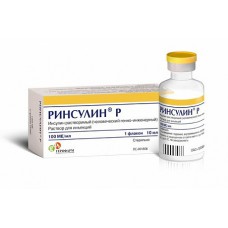Expiration date: 07/2026
The composition and form of issue:
Solution for injection. 1 ml contains:
insulin human genetically engineered 100 IU
excipients: metacresol glycerol water for injections
in vials of 10 ml in a cardboard pack 1 bottle.
Description pharmaceutical form:
Colorless transparent liquid.
Feature:
Rinsulin R is human insulin obtained by recombinant DNA technology.
Pharmacokinetics:
The fullness of the suction and the beginning of the effect of insulin depends on the method of administration (p/a, I/m), the site of injection (abdomen, thigh, buttocks), dose (amount of insulin), insulin concentration in the product, etc. Distributed in the body unevenly penetrates through the placental barrier and in breast milk. It destroyed insulinase mainly in the liver and kidneys. T1/2 — a few minutes. Excreted by the kidneys (30-80%).
Description pharmacological action:
The short-acting insulin.
Interacts with the specific receptor zitoplazmaticescoy external cell membrane of cells to form insulin-receptor complex stimulates intracellular processes, including synthesis of several key enzymes (hexokinase, pyruvate kinase, glycogen, etc.). The decrease in the content glucose in the blood due to its increase of intracellular transport, increased absorption and assimilation tissue, stimulation of lipogenesis, glikogenogeneza, a decrease in the rate of glucose production by the liver, etc. The duration of action of insulin preparations is mainly due to the rate of absorption, which depends on several factors (e.g. dose, method and place of introduction), in connection with which the action profile of insulin is subject to considerable fluctuations as different people, and at one and the same person.
On average, after p/to the introduction of the drug begins to act after 30 minutes, the maximum effect is between 1 and 3 h duration — 8 h
Indications:
- diabetes mellitus type 1
- diabetes mellitus type 2: stage of resistance to oral hypoglycemic, partial resistance to these drugs (in combination therapy), intercurrent disease
- gestational diabetes
- urgent conditions in patients with diabetes mellitus, accompanied by decompensation of carbohydrate metabolism.
Contraindications:
- hypoglycemia
- increased individual sensitivity to insulin or any component of the drug.
Side effects:
Due to the influence on carbohydrate metabolism: hypoglycemic state (paleness, increased sweating, palpitations, tremor, hunger, excitement, paresthesia in the mouth area, weakness, headache, dizziness, reduced visual acuity). Severe hypoglycemia may lead to the development of hypoglycemic coma.
Allergic reactions: rarely — skin rash, Quincke's edema, rarely — anaphylactic shock.
Local reactions: hyperemia, swelling and itching at the injection site, with prolonged use — lipodystrophy at the injection site.
Other: swelling, transient reduction of visual acuity (usually at the beginning of therapy).
Drug interactions:
There are a number of drugs that affect insulin requirements. Hypoglycemic effect of insulin increase the oral hypoglycemic drugs, MAO inhibitors, ACE inhibitors, carbonic anhydrase inhibitors, nonselective beta-blockers, bromocriptine, octreotide, sulfonamides, anabolic steroids, tetracyclines, clofibrate, ketoconazole, mebendazole, pyridoxine, theophylline, cyclophosphamide, fenfluramine, lithium preparations, drugs containing ethanol.
The hypoglycemic action of insulin weaken glucagon, somatropin, estrogens, oral contraceptives, corticosteroids, iodine-containing thyroid hormones, thiazide diuretics, loop diuretics, heparin, tricyclic antidepressants, sympathomimetics, danazol, clonidine, epinephrine, blockers H1-histamine receptors, BPC, diazoxide, morphine, phenytoin, nicotine. Under the influence of rezerpina and salicylates may as weakening, and strengthening actions of the drug.
Method of application and dose:
P/to, in/m and/in. Dose and route of administration of the drug determined by the physician individually in each case based on the level of glucose in the blood.
The average daily dose ranges from 0.5 to 1 IU/kg (depending on the individual patient and blood glucose level).
The drug is administered 30 minutes before a meal or snack containing carbohydrates.
Temperature of insulin must correspond to room.
In monotherapy the drug the frequency of administration is 3 times a day (if necessary — 5-6 times a day). When the daily dose exceeds 0.6 IU/kg, should be administered in the form of 2 or more injections in different areas of the body.
The drug is usually injected s/C in the anterior abdominal wall. Injection can be made also in the thigh, buttocks or the deltoid region of the shoulder. It is necessary to change the injection site within the anatomical region to prevent the development of lipodystrophy. With subcutaneous injection of insulin must be careful when injecting not to fall into a blood vessel. After the injection you should not massage the injection site.
The/m and/in the drug can be administered only under the supervision of a physician.
Rinsulin R — short-acting insulin and is typically used in combination with insulin average duration of action (Insulin NPH).
Instructions for use:
The drug use if solution precipitate appeared.
The injection technique with the use of insulin in vials
If the patient uses only one type of insulin
1. Disinfect the rubber diaphragm on the vial.
2. To dial into the syringe, the air in the amount corresponding to the required dose of insulin. To introduce air into the vial of insulin.
3. Turn the bottle with the syringe upside down and dial the desired dose of insulin into the syringe. Remove the needle from the vial and remove air from the syringe. To verify the correctness of the set dose of insulin.
4. Immediately make an injection.
If the patient needs to mix two types of insulin
1. Disinfect the rubber membrane on the vials.
2. Directly in front of the set to roll the vial of long-acting insulin ("cloudy") between your palms until until insulin does not become uniformly white and cloudy.
3. To dial into the syringe, the air in the amount corresponding to a dose of "cloudy" insulin. To introduce air into the vial with "muddy" insulin and remove the needle from the vial.
4. To dial into the syringe, the air in the amount corresponding to the dose of short-acting insulin ("clear"). To introduce air into the vial with "transparent" insulin. Turn the bottle with the syringe upside down and dial the correct dose "transparent" insulin. Remove the needle and remove the air from the syringe. Check the correct dose dialed.
5. Insert the needle into the vial with "muddy" insulin, turn the bottle with the syringe upside down and dial the desired dose of insulin. To remove air from the syringe and checking the dose correctly typed. Immediately to inject insulin mixture typed.
6. Always recruit insulin in the same sequence described above.
Injection procedure
It is necessary to disinfect the skin, where the insulin will be introduced.
Two fingers to take the skin fold, insert the needle into the base of the fold at an angle of about 45 ° and introduce insulin into the skin.
After injection the needle should remain under the skin for at least 6, in order to ensure that the insulin completely.
If after removing the needle at the injection site appears blood, gently press the injection site swab dipped in disinfectant solution.
You must change injection sites.
Overdose:
Symptoms: may develop hypoglycemia.
Treatment: mild hypoglycemia, the patient can remove the, taking into sugar or carbohydrate-rich foods. Therefore, patients with diabetes are advised to constantly carry around a sugar, sweets, biscuits or sugary fruit juice.
In severe cases, the loss of patient consciousness/injected a 40% solution of dextrose (glucose)/m, p/K, V/ — glucagon. After recovering consciousness, the patient is recommended to take food rich in carbohydrates, to prevent recurrence of hypoglycemia.
Special instructions:
The drug use if solution precipitate appeared.
On the background of insulin therapy requires constant monitoring of glucose levels in the blood.
Causes of hypoglycemia in addition to insulin overdose may be: the replacement drug, skipping meals, vomiting, diarrhea, increased physical activity, diseases, lowering the need for insulin (liver and kidneys, adrenal, pituitary or thyroid glands), changing the injection site, as well as interaction with other drugs.
Incorrect dosing or interruption in insulin delivery, especially in patients with diabetes mellitus type 1 can lead to hyperglycemia. Usually the first symptoms of hyperglycaemia develop gradually over several hours or days. They include the emergence of thirst, frequent urination, nausea, vomiting, dizziness, redness and dryness of the skin, dry mouth, loss of appetite, the smell of acetone in exhaled air. If not treated, hyperglycemia in diabetes mellitus type 1 can lead to the development of life-threatening diabetic ketoacidosis.
The dose of insulin needed to correct for violation of thyroid function, Addison's disease, hypopituitarism, liver and kidneys and diabetes in individuals older than 65 years.
Correction doses of insulin may also be required if the patient increases the intensity of physical activity or change their habitual diet.
Accompanying diseases, especially infections and conditions accompanied by fever, increase the need for insulin.
The transition from one type of insulin to another should be under the control of level of glucose in the blood.
The drug lowers the tolerance to alcohol.
In connection with the possibility of some precipitation catheters is not recommended to use the drug in insulin pumps.
In connection with the primary purpose of insulin by changing his appearance, or in the presence of significant physical or mental stress may decrease the ability to drive a car or to control various mechanisms and other potentially hazardous activities, require increased attention and rapid mental and motor reactions.
Storage conditions:
Avoid freezing.


